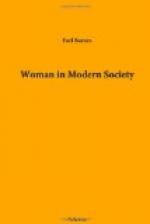From all this it follows that each half of the human unit must find the major part of its adult life in devotion to the one it has chosen as its complement. This is no hardship; it is divine opportunity, if love binds the lives in harmonious unity. If love is lacking, then there is no new organism; and such a case falls outside this discussion.
Under the simpler forms of civilization that have prevailed in the past, it was comparatively easy to find the complement for any particular man or woman. With physical sympathy and desire, little more was needed than common race and the same general social position. With simple personalities even the marriage of convenience was apt to prove happy.
But, to-day, not only have men become infinitely more complex and self-conscious than formerly, but women have ceased to be a general class; and, in becoming individuals, they have developed wide ranges of individual needs. Instead of fitting at the two or three points of physical desire, race and social position, a man or woman, to live strongly and well in this close union of body and soul, must fit each other at many points. To the older sympathies must be added a common attitude toward religion, education, artistic tastes, social ambitions, industrial aptitudes, and a score of other living sympathies, if the days are to pass in happiness, and each is to maintain his fair share of the life of the new unit. Physical desire still remains the paramount thing, but these other sympathies tend to strengthen it, or their absence may weaken and ultimately destroy it. It is comparatively easy for a person to find a complement to two or three of his, or her, qualities; it is very difficult for a person to find fulfilment for a score of his personal needs in another personality.
In earlier times, too, the individual reached such maturity as he or she was to attain much earlier than now, when education has become a life-long process. Once united, there was comparatively little danger that passing years would develop latent tastes that might prove dissimilar. To-day, complete union at twenty may mean many oppositions at forty, if each half of the unit goes on developing its powers. And we must add to this individual complexity and slower development of the present-day men and women the intense self-consciousness of modern times which makes it impossible for us to forget our conditions and go on living in a world once significant and true but now empty or false.




